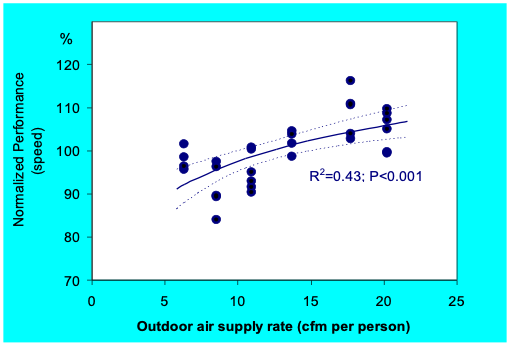Ventilation Rates and School Performance
Ventilation Rates and School Performance
Fisk [1] provides a review of the literature on the association on ventilation rates in schools with student performance. Eleven studies were reviewed. In five studies, student performance was based on students’ scores on standard tests of academic achievement and in six studies the researchers employed special tests to assess student performance. Five intervention studies increased ventilation rates during some periods to determine how the increases in ventilation affected student performance. Students were not told when ventilation rates were increased. Compared to cross sectional studies, these intervention studies are less subject to error from confounding by factors other than ventilation rate. Overall, eight out of 11 studies found statistically significant increases in at least some aspects of student performance when ventilation rates were higher. A ninth study reported a statistically significant increase in performance with a higher ventilation rate when using a less stringent than normal criterion for statistical significance. A tenth study reported increases in performance with higher ventilation rates that were not statistically significant. All five of the intervention studies found that student performance was higher when ventilation rates were increased. Performance improvements with higher ventilation rates ranged from a few percent to more than 15%. The evidence of improved student performance with increased ventilation rate was characterized as compelling.
As an example, consider a U.S. study [2] in 5th grade classrooms from 100 schools. This study used student performance in standard academic achievement tests as the measure of performance. In 87 classrooms, ventilation rates were less than the 15 cfm (7.1 L/s) per student minimum ventilation requirement in the ventilation standard applicable at the time of the study [3]. In these classrooms, performance in both math and reading tests increased with increased ventilation rate. The percentage of students passing the standardized math test increased by 2.9% (95% confidence interval was 0.9% to 4.8%) for each 2.1 cfm (1 L/s) per student increase in ventilation rate. The percentage of students passing the standardized reading test increased by 2.7% (95% confidence interval was 0.5% to 4.9%) for each 2.1 cfm (1 L/s) per person increase in ventilation rate. The analysis controlled for the socioeconomic status of the students and the number of students transferring into and out of the schools. These findings were highly statistically significant, i.e., unlikely to be chance findings. When data from all 100 classrooms were considered, test scores in both math and reading scores increased as ventilation rates increased to approximately 15 cfm (7.1 L/s) per student but then test scores diminished, on average, at higher ventilation rates. However, there was a great deal of variability in test scores from the small number of schools with the highest ventilation rates, thus, the trends in test scores as ventilation rates increased above 15 cfm was highly uncertain.
In another example, a Danish study performed within four classrooms [4-6], Wargocki and Wyon used performance tasks representing various aspects of schoolwork, from reading to mathematics that were embedded into the normal school work. The speed and accuracy of task performance was assessed. This study reported an 8% increase in speed of school work tasks with a doubling of ventilation rate. There was no statistically significant influence of ventilation rate on the number of errors made by students. Figure 3 provides more detailed results from this study.


Figure 3. Student performance versus ventilation rate based on study in Denmark [6]. Performance was based on the speed (left figure) and accuracy (right figure) of completing various school work tasks. The various data points represent results from multiple experiments and multiple types of work tasks. [Figure 3 reproduced with permission.]
In summary, the available scientific literature indicates the potential for a few percent to 15% increases in aspects of student performance, including and higher scores in standardized math and reading tests, with increased classroom ventilation rates. Ventilation rates in roughly half of U.S. public elementary school classrooms appear to be less than specified in codes [1]; thus, the opportunity for increasing student performance by increasing ventilation rates is substantial.
1. Fisk , W.J., The ventilation problem in schools: literature review. Indoor Air, 2017. 27: p. 1039-1051. https://dx.doi.org/10.1111/ina.12403.
2. Haverinen-Shaughnessy, U., D.J. Moschandreas, and R.J. Shaughnessy, Association between substandard classroom ventilation rates and students' academic achievement. Indoor Air, 2011. 21(2): p. 121-31. https://dx.doi.org/10.1111/j.1600-0668.2010.00686.x.
3. ASHRAE, ASHRAE Standard 62.1-2004 Ventilation for acceptable indoor air quality. 2004, American Society for Heating, Refrigerating, and Air Conditioning Engineers, Inc.: Atlanta Available from: 62-1-2004_addendasupplementpackage-a-b-c-d-g.pdf.
4. Wargocki, P. and D.P. Wyon, The effect of moderately raised classroom temperatures and classroom ventilation rate on the performance of schoolwork by children. HVAC&R Research, 2007. 13(2): p. 193-220. https://dx.doi.org/10.1080/10789669.2007.10390951.
5. Wargocki, P. and D.P. Wyon, The effects of outdoor air supply rate and supply air filter condition in classrooms on the performance of schoolwork by children. HVAC&R Research, 2007. 13(2): p. 165-191. https://dx.doi.org/10.1080/10789669.2007.10390950.